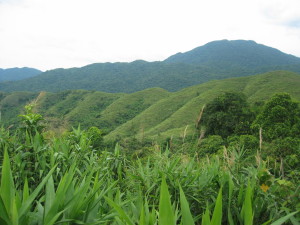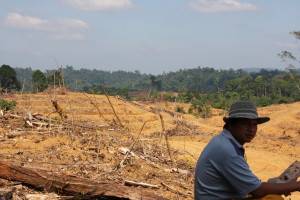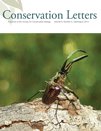Originally published at CIFOR’s Forests News

Research on key commodities such as oil palm, beef, soy and sugar forms part of Flagship 5 Global governance, trade and investment, of the CGIAR Research Program on Forests, Trees and Agroforestry (FTA). A new study suggests that Indonesia’s plans to expand sugarcane production endanger the country’s commitments to reduce emissions and pose a threat to forests and biodiversity. Harry Pearl spoke to researcher Sophia Gnych about her findings.
Key messages:
- One million hectares of forest could be lost under sugarcane expansion
- Expected emissions could thwart Indonesia’ GHG reduction efforts
- Alternatively use already deforested land and increase productivity
While global attention is fixed on palm oil and logging as major drivers of deforestation in Indonesia, researchers have issued a dire warning about a new threat—sugarcane.
The sugarcane sector is on the brink of a “government-engineered boom,”according to a new study—a boom that, if fully developed, could result in huge forest loss and undermine Indonesia’s goal of cutting greenhouse gas emissions.
As part of its national food security program, the Indonesian government is seeking to convert more than 1 million hectares of tropical forests to sugarcane plantations.
“The sheer number of hectares that they are making available is quite shocking,” said Sophia Gnych, a research consultant at the Center for International Forestry Research (CIFOR), who worked on the study.
“It leaves things open for a lot of potential conflicts with local communities, vast impacts on biodiversity, and carbon emissions.”
A sweet investment

Commercial cultivation of sugarcane is not new to Indonesia. Plantations were first established by the Dutch colonial administration around 1830, mostly in central and eastern Java.
By the 1930s, Indonesia was the world’s second largest producer of sugar and a net exporter. But by the turn of the century—due to liberalization of sugar production and trade policies—things had started to unravel.
Indonesia now has a deficit of 3 million metric tons of sugar per year.
That looks set to change, however, with government plans to boost production in the name of food self-sufficiency. Sugar, along with rice, corn and beef, is one of the four key commodities at the heart of Indonesia’s food security program.
As of 2011, Indonesia had 457,000 hectares of sugarcane plantations, but that will rise significantly if the government’s plan to expand outside of Java (the hub of Indonesian production) goes ahead, according to the researchers.
The government has developed preferential policies to boost production. In 2010, a law was passed allowing sugarcane concessions of up to 150,000 hectares—more than three times the maximum area allowed for other commodities, according to the study.
In Papua, the maximum area of sugarcane plantations has been set at 300,000 hectares, the authors say.

Sugarcane is also exempt from Indonesia’s Forest Conservation Moratorium. The moratorium, signed into law by former president Susilo Bambang Yudhoyono in 2011, is a key plank in the government’s plan to reduce the country’s greenhouse gas emissions—more than 80 percent of which are caused by deforestation and land conversion.
With the exemption in place, the report’s authors say more than one million hectares of forest—roughly the size of Jamaica—is marked for conversion to sugarcane.
Gnych says the extent and size of the proposed plantations is “much greater than other commodities”. “That acts as an incentive for investors. For investors to really develop the infrastructure and the processing facilities needed to go along with the plantations in these areas, a massive incentive needs to exist.”
A bitter taste

The main areas targeted for expansion are the southern part of Papua province and the nearby Aru Islands. They are covered in large tracts of primary and secondary tropical forest, and home to endemic biodiversity and vulnerable species.
The study warns that biodiversity will be threatened by conversion, as well as indigenous land claims. Furthermore, vast amounts of carbon could be released into the atmosphere.
Using IPCC Guidelines for National Greenhouse Gas Inventories, the study estimates that sugarcane development in the Aru Islands may result in the release of 106,274,212 tons of CO2 into the atmosphere, while in Papua the volume of net carbon loss may be 19,217,775 tons of CO2.
“Cumulatively, the development of sugarcane plantation in these areas would increase Indonesian greenhouse gas (GHG) emissions from land-use change and forestry by 20 percent, effectively negating the efforts and progress with REDD+ in other parts of the country,” the study concludes.
Alternative sweeteners
However, the authors say there are ample opportunities to increase sugar production without the expansion of plantations.
Among the study’s suggestions include the revision of existing plantation permits and spatial plans to strengthen the legal status of smallholder farmers. Smallholders dominate production in Indonesia, but many smallholder farms are located on land that is not registered with the national land agency. Gnych says this lack of legal clarity makes it hard for farmers to access credit. It also makes them less likely to participate in capacity building.
To achieve “significant gains” the study recommends:
- Improving smallholder productivity, or sustainable intensification
- Replanting with high-yield varieties and
- investing in transportation infrastructure and new mills.
Gnych says there are parallels with other agricultural commodities produced in Indonesia, including palm oil. Many of the challenges are common themes, such as improving efficiency and yield on land already under production. “This is something that you hear said again and again: there is already land that is under development, or is degraded and we should be looking to develop on that and improve yields among smallholders to meet the market demand,” she said.
“But the main challenges lie in capacity building, access to financing, and clarity on who can deliver that.”











